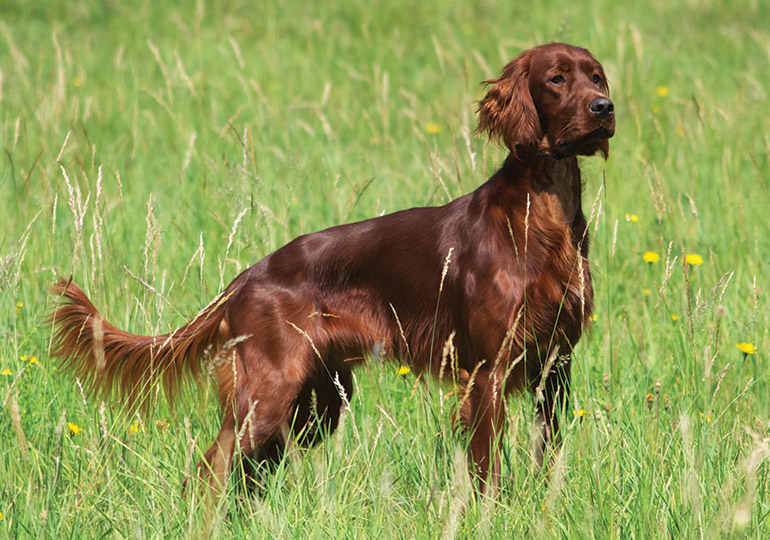Breeds
Irish Setter

GROUP 3 - GUNDOGS
History
Derived from a variety of spaniels, setters and pointers, the Irish Setter was initially a red and white dog, with shorter legs than today's breed. In the 19th Century following intensive selective breeding efforts, the lusterous, pure chestnut-red setter emerged, to win both prizes and hearts.
Red and white dogs of Setter appearance were present in Ireland in the early 1800s, but by the late 1800s entirely red dogs became more popular. The earliest English dog shows commencing in 1859 included both coloured varieties of widely differing appearances. The first standard was adopted in 1882 and has remained largely unchanged since then.
Temperament
In the 1970s Irish Setters gained the reputation for being stupid which was, and still is, unjustified. After a rapid increase in numbers, they suffered from the attention of ill-informed people who raised litters without adequate understanding of the breed’s requirements.
Most current breeders raise puppies with the correct care and attention and produce well-balanced dogs. The ANKC standard describes Irish Setters as ‘demonstrably affectionate’.
An intelligent dog, they are quick learners and excel at obedience training. They are high spirited and will give undying loyalty and love.
Appearance
The Irish Setter has been described as the world’s most beautiful dog, with its long, glossy, deep red coat. They should have an intelligent and friendly appearance and be active and substantial, yet elegant in outline.
Height: Dogs 27 ins & Bitches 25 ins (measurements being made at the withers) Weight: Dogs 33-35 kg & Bitches 27-30 kg
Suitability
Irish Setters have an excellent sense of smell, are extremely active and curious and learn very quickly. These characteristics mean they’re not suited to everyone. It is recommended that puppies are shaped and trained from a very early age. The most successful placements are with people who have owned dogs before, or at least owned horses or goats, and know how to train and manage animals.
Irish Setters should be brushed and combed regularly, this keeps their coat in condition, free from malls, knots etc. Always pay particular attention to under the stomach and between the legs so that knots don't cause the dogs any discomfort. Also, trim the hair between the toes as the hair can also knot and cause discomfort. It is not necessary to bath the dog every week but when you do, use a quality pet soap, shampoo and conditioner and remember to rinse out all soap, shampoo and/or conditioner.
Irish Setters need a good sized garden or yard (fully fenced and escape proofed) and regular walks are a very important aspect of ownership.
The Irish Setter is very friendly, will let you know if strangers are about and will play with children for hours.
As with all Setters, if brought up with other animals Irish Setters get along very well with them. Any new pet should be introduced slowly under strict supervision. The new pet could be crated and the Setter be allowed to see the new one after being made to sit and stay and then allowed to sniff the new pet through the bars of the crate whilst being restrained on a lead. This should be repeated at least twice every day until the setter is familiar with the new pet. That is, the new pet is held by you or is on your lap and the setter is relaxed with this situation. Introduction of a new pet can take up to two weeks. Always contact your breeder if you have any questions.
Before committing yourself, take a thoughtful look at your life-style. Is there room in your life for a dog? Are you prepared to take him to Puppy School to get him socialised. Later on it is also a good idea to seek out your local Obedience Club. Irish Setters are lively and affectionate and and can be stubborn, you need patience to train them but they are willing to please and excel at obedience training. You need to have time to walk the dog and consider whether it is fair to leave him alone for long hours. Of course the perfect solution is to own two Irish Setters so they are company for each other!
Information from The Irish Setter Association of NSW
Image: Shutterstock | By xxBedy
In Conclusion
Now you know a little about the Irish Setter you may think that this is the dog for you. Before you make a decision, please make contact with the breed club or your State controlling body for purebred dogs. They will be able to give you information about available puppies and also suggest dog shows where you can see the breed and speak to breeders. In this way you will gain a better perspective of the Irish Setter and its needs, and whether this breed would suit your lifestyle.
Breeders
Sorry, there are currently no breeders advertising for this breed. If you are a registered Dogs SA breeder and wish to advertise here please create an advertisement here.

